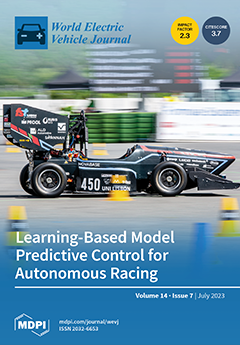In emergency situations, it is difficult to meet the requirements of safe driving only by relying on the braking system, and the probability of accidents can be reduced by employing an emergency lane-changing mode. To improve the adaptability of the distributed electric vehicle
[...] Read more.
In emergency situations, it is difficult to meet the requirements of safe driving only by relying on the braking system, and the probability of accidents can be reduced by employing an emergency lane-changing mode. To improve the adaptability of the distributed electric vehicle adaptive cruise control (ACC) strategy to complicated and volatile conditions, a multimode ACC strategy with emergency lane-changing function is proposed. Firstly, the ACC is divided into four modes aimed at the problem of complex conditions, and a switching strategy is designed to control the switching of them. Simultaneously, the car-following mode is divided in greater detail based on time to collision (TTC), and the acceleration weighted average algorithm is adopted for accuracy and output continuity during switching. Then, the ACC is established with a hierarchical control framework, in which a PID-based cruise mode and a multi-objective optimized car-following mode based on model predictive control (MPC) are devised. The target brake wheel cylinder pressure is selected as the emergency brake pressure in takeover mode. In addition to the MPC-based system, the emergency lane-changing mode incorporates a yaw moment controller in the upper-level controller to improve body stability during emergency lane changing in the upper-level controller. In the lower-level controller, the upper-level output is converted into driving torque, wheel cylinder pressure, and front wheel angle to control vehicle travel and generate additional yaw moment. Finally, the results indicate that the presented multimode switching strategy can adapt to complex and instable transportation environments. In the cruise control scenario, the host vehicle can rapidly reach cruising speed within 5 s. In the car-following scenario, the host vehicle can stably follow the preceding vehicle with an acceleration of −5–3.5 m/s
2 and a jerk of −2–2 m/s
3 throughout the entire process, maintaining a safe distance from the preceding vehicle. In emergency lane-changing scenarios, vehicles with body stability control can better follow the lane-changing trajectory, and tracking accuracy is improved by 65%. Simultaneously, parameters such as front wheel angle, yaw rate, sideslip rate, and lateral acceleration remain within the normal range. In mixed switching scenarios, each mode can be correctly switched according to diverse operating conditions, and obstacle avoidance can be accomplished through horizontal and vertical strategies, which also verify the effectiveness and rationality of the control strategy proposed.
Full article





